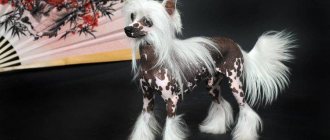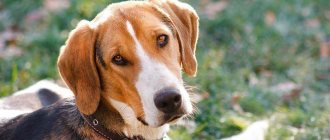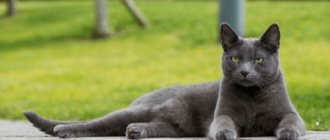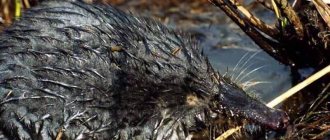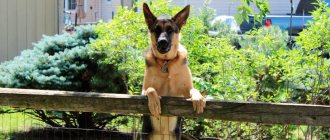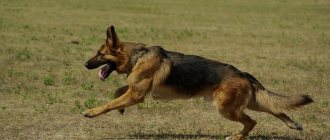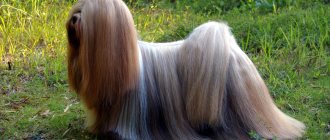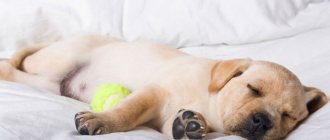Main characteristics
| Breed parameters | |
| Country of origin: | Russia |
| Weight of the breed: | males: 25-35 kg, females: 25-35 kg |
| Height at withers: | males: 58-68 cm, females: 58-64 cm |
| Temperament: | calm |
| Wool: | average |
| Role in human life: | hunting |
The Piebald Hound is not a companion dog and is not recommended for apartment living. The dog needs freedom and constant physical activity. If you are not a hunter, then this breed is not for you.
Description of the Russian Pinto Hound breed standard
Breed standard: The Russian pinto hound breed standard was approved by the Presidium of the Russian Federation of Hunting Dog Breeding in 1994.
Breed classification: Group 6. Hounds, bloodhounds and related breeds.
Features of the breed: the Russian piebald hound dog (see photo above) has a strong, massive bone structure and well-developed muscles. The skin is dense, smooth, and does not form folds. The head is of medium size, oblong, voluminous, but not wide, with a smooth transition from the forehead to the muzzle.
The muzzle is rectangular in shape. The occipital protuberance is poorly defined, the back of the head is slightly rounded. The lips are tightly closed and do not droop. The nose is large and black. The teeth are white, strong, with a scissor bite. The eyes are oval, slanted, dark brown, with dark eyelids. The ears are thin, hanging, triangular in shape, close to the head, slightly rounded, set high. The neck is rounded, muscular, its length is equal to the length of the head.
The chest is wide, deep, with barrel-shaped ribs. The stomach is tucked. The back is wide, strong, with a short, convex loin. Limbs are straight, dry, bony, strong. The feet are oval or round, arched, with tightly clenched toes. The tail is saber-shaped, thick at the base, tapering towards the end. Raised up.
The hair on the head, ears, and limbs is short, on other parts of the body it is longer (5–6 cm). The tail is evenly covered along its entire length with straight, thick hair. The undercoat is well developed.
Coat color is black and piebald, black, black and piebald with blush. The size of the spots may vary. Blush is present on the head, shoulders, lower body, and along the edges of the side spots.
Height at withers for males: 58 – 68 cm; females: 55 – 65 cm.
Origin story
At the beginning of the 19th century, every second person in Russia was breeding hounds, which led to confusion in the type and main characteristics. Every landowner who owned a kennel considered himself a great breeder.
Towards the middle of the 19th century, hounds lost almost all their anger towards wild animals and became completely unsuitable for hunting larger predators, for example, wolves.
Foxhounds helped correct the situation. At that time, they were considered ideal hunters and had a fixed phenotype, that is, they conveyed hunting skills well, which hounds really lacked. As a result of such a tandem, elegant and very hardy animals appeared in Russia, which were distinguished by their great working capacity and aggression towards wild animals. From their Russian brothers they took a loud ringing bark and incredible speed.
At the beginning of the journey to create a universal hunting dog, there were many problems, but there were also successes. The problems were directly related to the fact that many breeders of that time worked with different infusions, which is precisely why the result was unstable. Closer to the 30s, certain leaders emerged who received more successful specimens in terms of exterior and temperament. The most successful were: S. M. Glebova, I. L. Kramarenko, P. A. Bereznikova.
At the beginning of the 20th century, mixed breeds of Russian hounds and fox terriers began to be purposefully bred. By this time, the new breed had already successfully declared itself and perfectly demonstrated its qualities at local and regional exhibitions. In addition, they were assigned their own name - Anglo-Russian hounds.
Unfortunately, after the collapse of the Russian Empire, the newly created breed was on the verge of complete extinction. The general phenotype was again lost and some working qualities were lost.
In 1925, the first standard was developed, which instantly increased the value and importance of the hunting breed. Before the start of the Second World War, the population was about six elite lines. Regarding the name change, this procedure was carried out in 1947. According to other sources, the name changed in 1951.
Description and breed standard
The Russian Piebald Hound breed is not recognized by the FCI.
From the English, Russian hounds adopted the speed of pursuing prey (paraty), and in appearance they are similar to foxhounds (English hounds, “foxhounds”). But the musicality of barking, which was highly valued by Russian hunting enthusiasts, was cultivated only by Russian breeders.
The first Russian standard was written in 1925, but the breed was called “Anglo-Russian hound”. Later (in 1947 or 1951 - the data differs) it was renamed the Russian piebald hound, the standard was changed several times.
Breed standard
Now, according to the standard, the Russian piebald hound must have:
- The dog is strong and quite large. The height at the withers of males (breeders) is from 58 to 68 cm, shorter females (cutters) are from 55 to 65 cm.
- In search of an animal, the dog moves at a gallop or at a wide trot; in pursuit of prey, it moves at a sweeping pace.
- Color black and piebald with tan (“blushed”). The belly and paws are always white.
- The hair is short on the ears, head, and legs. On the body and tail the hair is longer, about 4-5 cm. The undercoat is good and dense.
- The ears are hanging, close to the head, and the tips are rounded.
- The eyes are brown, dark brown, the eyelids are dark at the edges.
- The bones are strong, with good muscles.
a brief description of
The Russian Piebald Hound is a very hard-working dog that loves what it does. It turns an ordinary hunting trip into an exciting and fun game. Along with high activity, these dogs are endowed with a balanced psyche and a relatively calm temperament.
Hounds are very sociable, they quickly find a common language with the owner and are happy to help him in his daily work and worries. These animals will always be nearby during your daily jog, will keep you company during a trip to nature, and will join the family picnic. However, despite the apparent devotion to the family, these dogs are primarily hunters; for them, work will always come first. Therefore, you can earn their trust only by being an avid hunter.
External characteristics of the puppy
When choosing a Russian Pinto Hound puppy, attention must be paid to the general condition and appearance of the puppy. The baby should be strong, bony and large. The tail should not fall over. You need to examine the stomach for the presence of a hernia and the lower jaw, which should not extend beyond the upper.
Height
The pinto hound puppy grows quite quickly. At 1.5 months at the withers their height reaches 35 cm, at 3.5 months their height can be about 46 cm, at 5.5 months - 58 cm. The puppy will reach the parameters of an adult by 7-8 months.
Breed standard
Despite the close relationship between the piebald breed and the Russian hound, they are not exact copies of each other. Sometimes in hunting it is quite difficult to distinguish one from the other; the only difference is the spots on the pinto and the characteristic blush. In addition, there are some differences in the shape of the ear, as well as in movements.
- At the withers, piebalds can reach 68 cm, females are slightly lower, their weight is on average 30 kg.
- head is dry, oblong, with an average width of the skull, and not particularly voluminous. The occipital protuberance and brow ridges are slightly marked. The transition from the nose to the forehead is clearly expressed, the stop is gentle. In profile, the muzzle has the shape of a rectangle.
- The jaw is strong, the teeth are massive, even, white, scissor bite. The bridge of the nose is smooth, the mirror of the nose is clearly defined, voluminous, and black. The eyes are small, oval-shaped, slightly slanted, the eyelid is dark in color. Brown iris (all variations).
- The ears are triangular in shape, slightly rounded at the tips, drooping, the tips are approximately at eye level. The neck is moderately muscular, slightly rounded.
- The body is strong, with a low, massive chest, which is lowered to the level of the elbows, the back is wide, the croup is convex, and the groin is concave. The limbs are dry, bony and at the same time muscular. The paws are oval-shaped or rounded, gathered into a fist.
- The tail is saber-shaped, thick at the base and tapering towards the end. Leather without dewlap or unnecessary folds.
- The coat is double, of medium length, shorter on the paws, head and ears, in other areas it is approximately 5 cm longer. The longest coat is on the back of the neck and the outer side of the thigh. The undercoat is thick and dense.
- Acceptable color : the most common is black-and-piebald in blush, also there are purple-piebald with small patches, and gray-piebald in blush.
Vices:
- Any other eye color that differs from that specified in the standard.
- Tail drooping, curled or curled to one side.
- Steep stop, hump on the nose or upturned nose (snub nose).
- The presence of folds and their large number.
- Ears curled into a tube, excess hair.
- Lack of undercoat.
- Wavy wool.
- Dense speckled color.
- Clubfoot.
External characteristics of an adult
It is almost impossible to confuse the Russian hound with its “offspring” - the piebald huntress, except in rare cases. The new species differs from the “parent” in color, coat structure, and type of ear tissue.
The first appearance standard for piebald hounds was adopted in 1925. According to him, an adult must have the following characteristics:
Maximum height
The maximum for males is 68 cm, the minimum is 58. For females, the maximum height should not be more than 64 cm and not less than 58 cm.
Weight
The body weight of a hunting dog of this breed should not exceed 35 kg and be at least 25 kg.
Features of color
Most often, the piebald hound can be found in black and piebald color, diluted with tan. Black spots can be of any size and even turn into saddlecloth. Tan can be located on the head, shoulders and near the tail. The paws and belly should be completely white.
Wool
The fur coat of a breed bred in Russia simply cannot lack undercoat. The coat itself can be double length with the shortest hairs on the ears, head and paws. The longest spines are on the neck and hips (their outer side).
Ears, tail
Dogs' ears are set high and always hang down. The canvas itself is slightly rounded. The tail is thick at the base and tapers towards the tip of the tail. The standard length is the length to the hock joint.
Character and temperament
Outside of the hunting process, piebalds are calm and even lazy creatures; they do not cause any special problems, however, they have some features that the owner will have to get used to. In their free time from running, they prefer to accumulate energy, which they splash out in full on the next hunting trip. Consequently, they are practically not active at home.
These animals are too independent and independent, so they will never do what they try to force on them. For example, instead of humiliating themselves and begging for food, as many other dogs do, they will choose to take it without permission. In addition, they will not be shy to do this right in front of their owner and the entire family as a whole.
Character
Dogs have an extraordinary temperament against the backdrop of pronounced hunting qualities . By nature, the piebald hound is a rather obstinate creature . The animal accompanies its dissatisfaction with a heart-rending bark, and may even growl.
It should be noted that the voice of the Russian Pinto Hound was initially noted as the main characteristic of the breed and was considered quite musical. By barking, a dog expresses its state - from desires to grievances. This quality is indispensable when hunting, but in everyday life it can become a serious irritant. Fortunately, well-mannered pets prefer to behave with restraint at home.
Dogs become attached to their owner and even help in raising children , playing outdoor games with them and protecting them from uninvited guests. As for other pets, here the Russian hound can show all its temper, even to the point of aggression, even if it grew up with pets, as they say, from the cradle.
Education and training
Many dog experts say that Russian piebalds have fairly high intelligence and good memory. However, excellent mental abilities do not guarantee obedience and attentiveness. Quite often during training, innate independence takes over, and the makings of a leader do not allow one to “bend the knee.”
Due to excessive self-will, it is recommended to socialize the dog as early as possible and train it from a very early age. Ideally, as soon as the puppy crosses the threshold of a new home.
Innate stubbornness and attempts to assert oneself will have to be taken for granted, since these qualities are inherent in nature itself and it is almost impossible to eliminate them. During classes, try to always leave the last word for yourself, never follow the dog’s lead, otherwise he will think that he is the head of the family. At the same time, in the process of education there should be no violence, swearing or too loud shouting. It is best to use rewards in the form of treats and dog treats.
Education experts recommend starting training at approximately 4 months of age. The first thing the dog must learn is the commands “sit”, “near”, “lie down” and “come”. By 5 months, the pet should master the muzzle, and you can also begin to teach it to swim.
Animal character
First, you need to remember that the Russian hound dog is intended for hunting, hence the specificity of its behavior, character and instincts. Dog handlers define the breed as balanced and psychologically stable. The animal always shows friendliness towards people. The hound will become a faithful and devoted friend for the owner.
Experts were able to revise the breed standard only in the middle of the last century
A very intelligent Russian piebald hound sincerely becomes attached to a person and becomes an excellent assistant in hunting activities. The ability of a dog of this breed to drive and chase an animal is at the highest level.
Hunting with Russian piebald
The main purpose of the breed is productive hunting, which is exactly what they were bred for. The dog shows aggression towards wild animals, runs fast and gets excited while working. She is very efficient and hardy, hunting with her is a pleasure. It is worth noting that Russian piebalds turned out to be more vocal than their hunting relatives, while they are heavier in running, but with a wider search range. An additional bonus for the owner is the elegant color, which does not blend into the terrain and the animal is clearly visible in the forest, therefore, the dog cannot be confused with prey.
To achieve good results in hunting, hounds will have to be trained, you need to be prepared for this. That is, if you want to see your assistant as a provider, and not just a pursuer, then you will have to work productively.
The breed perceives other animals as potential prey, so you need to be very careful when walking, because even a large dog can be perceived as a target for destruction.
You need to start introducing your dog to hunting either in the spring or in the fall, when there is not yet a carpet of snow on the ground. The puppy is simply taken out into the forest and given the opportunity to get acquainted with the area and different smells. This kind of walk should be intense, but not exhausting. The puppy should enjoy spending time in the forest, and not be discouraged from such trips.
You should not let your teenager follow fresh tracks of animals, as he will eventually get used to easy tasks and will not pick up a late trail. In addition, you need to teach your pet to notify its owner about the found trail, and not silently follow it.
Maintenance and care
Like most hunting breeds, piebalds are adapted to the conditions of mid-latitudes. They have a slightly poorer coat than the rest, however, they are quite capable of spending the night in an unheated barn and not getting sick. However, this does not mean that they should live in such conditions permanently. The pet must have a warm booth.
You will have to walk your pet often and for a long time, but if the animal has an enclosure, then the dog itself will find something to do and knead its bones. It is important to remember that this breed is prone to escape, therefore, the fence in the enclosure or in the common area should be high enough.
Some owners manage to keep such a pet in an apartment, however, this should not be an example to follow, these dogs need space and fresh air.
The piebald, despite its craving for long walks, does not require any special care at all. These animals take excellent care of themselves; they can easily be called an ideal pet for lazy owners.
Dogs are bathed extremely rarely and only when necessary. Small puppies are not washed at all until they are three months old. In terms of coat care, everything is quite simple here; they only need to be combed a couple of times a week with a special brush to remove dead hairs. During the molting period, the procedure should be repeated somewhat more often.
This breed is prone to conjunctivitis, so the eyes need special care and attention from the owner. They should be regularly wiped with a damp cotton pad soaked in a special lotion.
Ears are cleaned once a week. To do this, you can use special lotions to clean your ears.
Since dogs often have to run through the forest, they need to be regularly checked for ticks and their paw pads examined, as they are often injured. In winter, they need to be lubricated with wax. Claws are trimmed as they grow.
Features of maintenance and care
The ideal option for keeping a Russian pinto is a private house with a large local area. The apartment is not suitable as a place of permanent residence. The Russian piebald hound dog tolerates cold well due to its thick undercoat. If the dog is kept outside, then the kennel is additionally insulated for the winter.
Grooming
An unpretentious dog, the Russian Piebald Hound does not require careful grooming. You need to wash with shampoo no more than once every two months. The presence of a thick undercoat minimizes brushing. It is enough to do this once every two weeks. On warm days, the dog can swim in open water, which he does with pleasure.
Nail care is not required if the Russian Pinto spends most of its life outside. The claws wear down naturally.
Ear care is important especially in spring and summer. It is necessary to inspect the inner surface of the ears for the presence of mites. There are protective sprays against blood-sucking insects. They can be used to prevent or minimize risk.
Dental care includes examining your mouth once a week. It is recommended to brush your dog's teeth with a special toothpaste. Tomatoes, apples, and stringy seeds are offered to dogs as natural cleansers.
Walk
The hound should only be walked on a leash. Her hunting instincts are too developed. If she smells another animal and decides to track it, then no shouts from the owner will stop her. When hunting, it is characterized by endurance and an amazing ability to track an animal for a long time and follow its trail. For a Russian piebald to become a helper and breadwinner, instincts are not enough. Proper training in the basics of hunting, correct upbringing, early entry into the forest for training - these are a number of points that will help a young hound become a real hunter.
Feeding
The Russian piebald hound dog is extremely active and physically strong. To ensure the normal functioning of the animal, a menu is drawn up that will completely satisfy the body in microelements, vitamins, and nutrients. When feeding natural products, the main part is given to meat. The Russian piebald hound needs it every day. By-products are also suitable. But the liver and kidneys are given boiled to avoid infection with worms.
Table of required products for a natural diet:
| Squirrels | Fats | Carbohydrates |
| Meat (including offal) | Milk | Crackers |
| Eggs (yolk only) | Butter | Cereal porridge |
| Fish | Vegetable oil | Vegetables |
| Fresh blood from slaughter animals | Sour cream | Fruits |
| Dairy products |
Every day the pet is given a large raw bone to chew on. Vegetables, fruits, and herbs are offered to replenish vitamin reserves.
List of prohibited products:
- Fatty dishes.
- Egg white.
- Smoked meats.
- Pickles.
- Citrus.
- Confectionery.
- Chocolate.
- Legumes.
- Tubular bird bones.
When there is not enough time, people use dry food. Modern industry offers various lines of dry granular food according to the breed, size, and age of the pet. The use of dry granules is convenient because by eating a certain portion, the dog receives all the necessary nutrients and vitamins.
When consuming dry granulated food, the animal must always have access to water.
Feeding
The ideal diet for hounds is fresh, raw meat and offal. It can be supplemented with certain types of cereals, fresh vegetables and fruits. During preparation for hunting, the daily norm is reduced by a third.
Once a week, you can give your pet lean sea fish without bones, but the portion will have to be slightly increased. You can also occasionally introduce a quarter of an egg and occasionally indulge in dog treats. In addition, you can give out sugar bones as incentives.
Industrial food is highly not recommended for hunters.
Care and maintenance
The breed is completely easy to maintain . Dogs are a priori not intended to be kept in an apartment . Even in a private home, it is preferable to keep animals in a spacious enclosure , closing them only during periods of bad weather.
Caring for a dog is completely simple . Dogs are brushed once a week, but during the shedding period the procedure is increased, brushing the pet every other day. The dog wears its claws down on walks itself. The dental system is naturally strong; only with age, some representatives of the breed may develop plaque that needs to be cleaned in a veterinary clinic.
Eyes and paw pads are examined daily. It is necessary to clean your pet's ears regularly and preferably every day.
But bathing a Russian pinto is often not recommended. In the summer, the dog itself swims beautifully in open water, and in the winter it knows how to clean itself with snow.
Health
These dogs naturally have excellent health and a stable immune system. They rarely get sick and have virtually no genetically inherited problems, with the exception of dysplasia. However, like any animal, they can catch a virus, so it is very important to promptly vaccinate your pet and treat it against parasites.
Adults are prone to dermatitis and may have an allergic reaction, in which case the dog’s diet will have to be reconsidered.
Sometimes animals suffer from the following diseases:
- Pseudorabies.
- Polyneuropathy.
- Conjunctivitis.
- Myositis.
